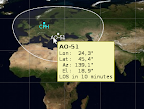Recording audio with gstreamer is easy:
gst-launch -e pulsesrc ! audioconvert ! \
lamemp3enc target=1 bitrate=64 cbr=true ! \
filesink location=audio.mp3
The pulsesrc element here refers to the pulseaudio input (pulseaudio is AFAIK the default sound system in all linux distributions nowadays). This is good and will capture audio from the default sound input, which can be microphone or line-in depending on the hardware and the pulseaudio configuration.
But what if I plug in my USB webcam with built-in microphone and I want to capture audio from that?
 You may have already seen tooltips in the Gpredict user interface. I have made extensive use of them for providing short description of the functionality of the GUI controls all over the application. Lately, I have felt a desire to extend the usage of tooltips to also include graphical objects like satellites shown on the map or the passes shown in the “Sky at a glance” module.
You may have already seen tooltips in the Gpredict user interface. I have made extensive use of them for providing short description of the functionality of the GUI controls all over the application. Lately, I have felt a desire to extend the usage of tooltips to also include graphical objects like satellites shown on the map or the passes shown in the “Sky at a glance” module.